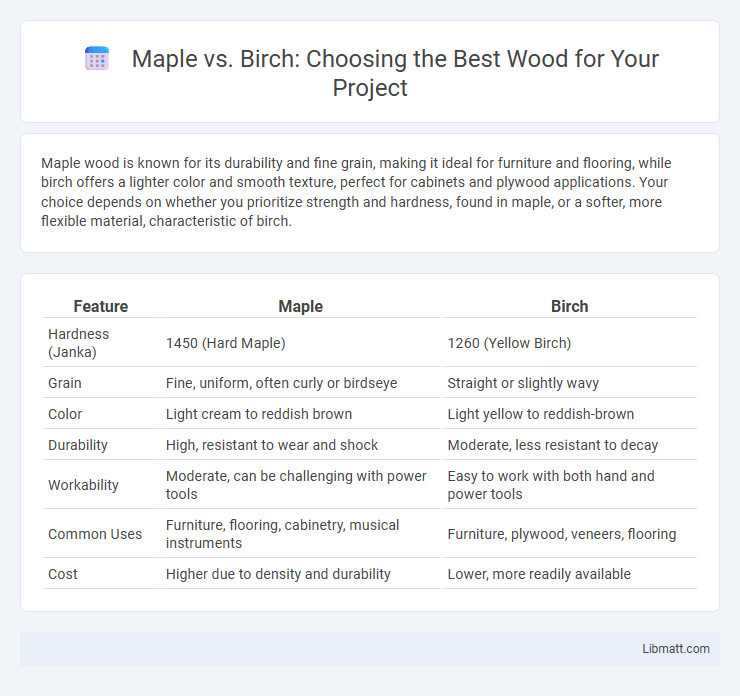Maple wood is known for its durability and fine grain, making it ideal for furniture and flooring, while birch offers a lighter color and smooth texture, perfect for cabinets and plywood applications. Your choice depends on whether you prioritize strength and hardness, found in maple, or a softer, more flexible material, characteristic of birch.
Table of Comparison
| Feature | Maple | Birch |
|---|---|---|
| Hardness (Janka) | 1450 (Hard Maple) | 1260 (Yellow Birch) |
| Grain | Fine, uniform, often curly or birdseye | Straight or slightly wavy |
| Color | Light cream to reddish brown | Light yellow to reddish-brown |
| Durability | High, resistant to wear and shock | Moderate, less resistant to decay |
| Workability | Moderate, can be challenging with power tools | Easy to work with both hand and power tools |
| Common Uses | Furniture, flooring, cabinetry, musical instruments | Furniture, plywood, veneers, flooring |
| Cost | Higher due to density and durability | Lower, more readily available |
Introduction to Maple vs Birch
Maple and birch are two popular hardwoods commonly used in furniture and flooring, each offering distinct characteristics. Maple is known for its fine, uniform grain and exceptional durability, making it ideal for high-traffic areas, while birch features a slightly coarser grain with warm, creamy hues that add natural beauty. Understanding these differences helps you select the best wood for your project based on aesthetics, hardness, and workability.
Botanical Differences Between Maple and Birch
Maple trees, belonging to the genus Acer, feature opposite leaf arrangement and typically have lobed leaves with distinct veins, while birch trees, from the genus Betula, exhibit alternate leaf arrangement with simple, often serrated leaves. Maples produce samaras as their winged fruit, contrasting with birches that produce small nutlets in catkin clusters. Bark texture also differs significantly; maple bark is generally smoother with vertical grooves, whereas birch bark is famously papery and peeling, often white or silver.
Wood Grain and Appearance Comparison
Maple wood grain is typically fine and uniform, offering a smooth, consistent texture with subtle waves or curls, making it ideal for sleek modern designs. Birch features a slightly more pronounced grain with gentle curves and occasional knots, providing a warm, rustic charm with varied patterns. Your choice between maple and birch will significantly impact the visual appeal and character of your woodworking project.
Strength and Durability: Maple vs Birch
Maple wood is known for its exceptional hardness and durability, often rated higher on the Janka hardness scale than birch, making it ideal for heavy-use flooring and furniture. Birch offers decent strength and wear resistance but tends to be softer and more prone to denting compared to maple. For applications demanding long-lasting toughness and resistance to impact, maple is generally the superior choice over birch.
Common Uses in Furniture and Flooring
Maple is highly valued in furniture and flooring for its durability and fine grain, making it ideal for cabinets, hardwood floors, and wear-resistant tabletops. Birch, known for its light color and smooth texture, is often used in residential furniture, plywood, and veneers due to its affordability and ease of staining. Your choice between maple and birch will depend on whether you prioritize hardness and longevity or cost-effectiveness and aesthetic versatility in your wood projects.
Cost and Availability: Which is More Economical?
Maple is generally more affordable and widely available compared to birch, making it a cost-effective choice for your woodworking projects. Birch tends to be pricier due to its limited supply and higher demand in specialty applications. Considering budget constraints, opting for maple often provides the best balance of quality and economy.
Maintenance and Care Requirements
Maple requires moderate maintenance with regular sealing to protect its dense grain from moisture and wear, while birch demands more frequent refinishing due to its softer wood prone to dents and scratches. Your choice between maple and birch impacts the frequency of upkeep, as maple's durability reduces the need for repairs over time compared to birch. Proper cleaning with gentle, wood-safe products extends the lifespan of both, but maple's natural hardness offers better resistance to daily wear and tear.
Environmental Impact and Sustainability
Maple and birch trees both offer sustainable options for wood products, but maple typically has a slower growth rate, which may result in a higher environmental impact over time compared to birch, known for its rapid regeneration. Birch forests help maintain biodiversity and soil health due to their ability to thrive in diverse conditions and support a variety of wildlife. Your choice between maple and birch can influence sustainability efforts depending on timber sourcing practices and forest management strategies.
Maple vs Birch: Pros and Cons
Maple offers a dense, durable hardwood ideal for flooring and furniture, with a smooth grain that resists wear but may be prone to staining without proper finishing. Birch features a fine grain and lighter color, providing a cost-effective option with good strength but less resistance to dents and moisture compared to maple. Your choice depends on whether you prioritize durability and hardness (maple) or affordability and aesthetic appeal (birch).
Choosing the Right Wood: Factors to Consider
Maple offers durability and a tight grain ideal for heavy-use furniture, while birch provides a smoother finish and a lighter color suitable for modern aesthetics. Your choice should consider factors like hardness, grain pattern, and resistance to wear, with maple generally outperforming birch in strength but birch being more cost-effective. Evaluating these characteristics ensures you select the right wood for your project's functional and visual requirements.
Maple vs birch Infographic

 libmatt.com
libmatt.com